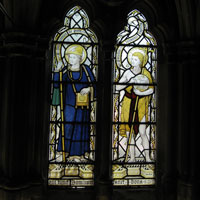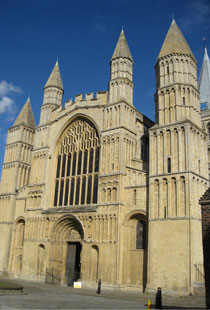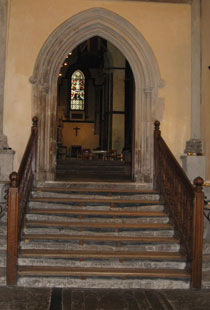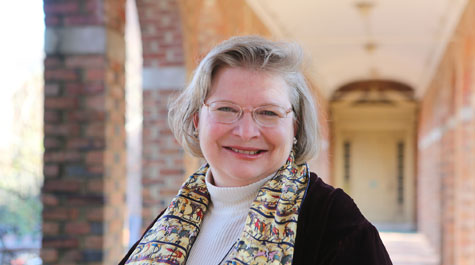Forgotten saint sparks W&M professor’s curiosity
Suzanne Hagedorn was poking around Rochester Cathedral in England looking for written information on the obscure Roman Catholic saint William of Perth when she realized something.
She could find hardly anything, even in the cathedral where William was venerated at a shrine for centuries during the Middle Ages.
That was three years ago, and Hagedorn, associate professor of English and affiliated faculty with the Medieval and Renaissance Studies program at William & Mary, has been researching St. William ever since.
“The thing about England and pilgrimage is that a lot has been lost,” Hagedorn said. “The destruction of many saints’ shrines occurred as a direct result of the dissolution of the monasteries by Henry VIII at the Protestant Reformation.”
 Hagedorn ran across the peculiar story quite by accident. In the summer of 2016, the Geoffrey Chaucer specialist took a trip to retrace the route of Chaucer’s pilgrims in “The Canterbury Tales” from London to Canterbury as part of preparing for a proposed COLL 300 class that she hopes to offer in 2022.
Hagedorn ran across the peculiar story quite by accident. In the summer of 2016, the Geoffrey Chaucer specialist took a trip to retrace the route of Chaucer’s pilgrims in “The Canterbury Tales” from London to Canterbury as part of preparing for a proposed COLL 300 class that she hopes to offer in 2022.
The rediscovery of traditional pilgrimage routes in England and Scotland has been part of the recent revival of interest in spiritual pilgrimage along routes such as the Camino de Santiago in Spain.
Hagedorn gave a paper on the topic of the “lost saint” William at W&M’s Institute for Pilgrimage Studies symposium in November, and she will give a poster presentation on this topic next summer at the New Chaucer Society’s congress in Durham, England.
William was a resident of Perth, Scotland, who was a baker known for donating one of every 10 loaves he baked and for taking care of poor widows and orphans, according to Hagedorn. He had adopted an infant who was left at the door of a local church and taught him to be a baker, and was traveling with the boy on pilgrimage to Rochester, Kent.
William died while in Rochester in 1201, and the lore is that the boy was suspected in his death, Hagedorn said. The Bishop of Rochester Cathedral eventually received permission from the pope to venerate William as a saint and set up a shrine to him, which pilgrims visited to give alms and to pray to the murdered pilgrim.
Later Protestant writers, who disapproved of pilgrimage, even accused monks of deliberately having William murdered. Their motivation would have been to make money off of a shrine in his honor — rivaling that of the famous Thomas à Becket at Canterbury — as Rochester weathered tough economic times. But that far-fetched theory doesn’t hold much traction, according to Hagedorn.
“It's a murder mystery, because clearly you have a dead man who presumably showed signs of violence, otherwise they wouldn't have accused the boy who traveled with him of killing him,” Hagedorn said. “But we don't really know. Do I think that the monks of Rochester Priory had him murdered? No, I do not think they ordered a hit. So we don't know who killed William. It's a real mystery.”
 William’s shrine was a major attraction in the Middle Ages, but was destroyed during the Protestant Reformation. Today, its former site is still marked in the cathedral, but none of its original components remain.
William’s shrine was a major attraction in the Middle Ages, but was destroyed during the Protestant Reformation. Today, its former site is still marked in the cathedral, but none of its original components remain.
The steps leading up to the ante-chamber through which pilgrims passed on the way to the shrine are very worn down and covered with wood.
“The patterns of wear on the stairway tell us that this was a popular shrine,” Hagedorn said. “It was heavily trafficked. The biggest shrine in England during the Middle Ages would have been St. Thomas à Becket’s, while competing with Becket — or maybe running a close second, depending on whom you talk to — was the shrine to Mary the Virgin in Walsingham.
“So the evidence of account books and the physical evidence in the cathedral itself suggest that after Becket and the shrine to Mary in Walsingham, the shrine of St. William at Rochester was a pretty big deal.”
The circumstances of William’s canonization, apparently granted by the pope around 1256, are very unclear, Hagedorn points out. A miracle attributed to the saint right after William’s death describes a previously insane woman being cured after placing a crown of honeysuckle on his head and then on her own. One later written account said that after this miracle, people prayed to William and he was responsible for other miracles, but it does not detail any of them, according to Hagedorn.
After the Protestant Reformation, some writers criticized the monks for fast-tracking William’s canonization in a desperate attempt to make money during hard times. Local wills and the cathedral’s account books show that people contributed candles to burn at William’s shrine though scholars have no idea what it looked like, according to Hagedorn.
Few remnants of William’s life remain today, and even fewer people these days know who he was.
A stained glass window installed in 1911 in Rochester Cathedral shows an artist’s imaginary depiction of William as a pilgrim who wears the scallop shell that symbolizes the pilgrimage to Santiago de Compostela in Spain.
 William is no longer listed in the Roman Catholic Church’s most recent reissue of its calendar of saints, though that does not mean he was de-sanctified, Hagedorn said. A road and an elementary school in Rochester, Kent, are named after him. But even a local historian whom Hagedorn met in Rochester only knew of William in passing.
William is no longer listed in the Roman Catholic Church’s most recent reissue of its calendar of saints, though that does not mean he was de-sanctified, Hagedorn said. A road and an elementary school in Rochester, Kent, are named after him. But even a local historian whom Hagedorn met in Rochester only knew of William in passing.
Like so many facts about his life, scholars have no idea whether Rochester was St. William’s final destination or if he just was passing through with plans to go to other medieval pilgrimage destinations, like Canterbury, Rome, Santiago de Compostela or even Jerusalem, Hagedorn said. Pilgrims often visited subsidiary shrines along the way to pray, make an offering and light candles.
Hagedorn would like to do more research in Scotland and possibly at the Vatican to see what evidence she can unearth about William and his canonization process. She also wants to take students with her as she retraces the route Chaucer’s pilgrims took in England.
“When you're on the road, you meet with all kinds of people and all kinds of things,” Hagedorn said. “In fact, Chaucer’s ‘Canterbury Tales’ consists of a whole bunch of people going on a trip, right? And they tell stories to each other.”
 Skip to main content
Skip to main content

